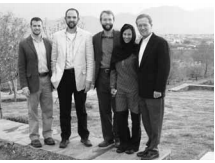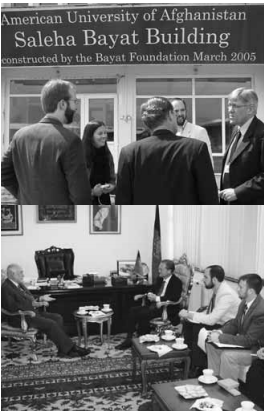Legal Education in Afghanistan: A Textbook Case
Standing at the front of his classroom this August, Mohammad Haroon Mutasem asks the students in Introduction to the Law of Afghanistan to open their textbooks. It is afternoon at the American University of Afghanistan (AUAF) in Kabul and the first class of the semester. As the students leaf through the text, it is hard to know which is more astonishing: that they are using the first law textbook of its kind in Afghanistan, or that their American peers at Stanford Law School wrote it. • “We knew going in that we couldn’t pretend to be experts on Afghanistan,” says Ben Joseloff ’08, who was in charge of writing the chapter on criminal law. “But we did have expertise being law students.”
Joseloff worked on the textbook as part of Stanford Law School’s Afghanistan Legal Education Project (ALEP), a new student-led initiative to help Afghan universities improve the quality of their legal education. The goal is to produce lawyers—and more of them—versed in current Afghan law and equipped to rebuild the country’s institutions after two decades of conflict. More broadly, the project team hopes to promote public understanding of formal law in a country where the rule of law remains weak.
A 2007 report issued by the United Nations and the Government of Afghanistan is telling: There are only 236 lawyers in the country licensed to represent clients in court. That’s one private lawyer for every 128,000 citizens.

Worse, new lawyers are often unprepared to practice law. According to lecturer in law Erik Jensen, an expert on rule of law in post-conflict countries, there is no school in Afghanistan that adequately trains students to be legal practitioners. Most courses are almost entirely theoretical. What’s more, the country’s six law schools—each divided into faculties that teach either Sharia law or a combination of civil law and political science—have outdated curricula that overlook such developments as the 2004 Constitution. Complicating this is a scarcity of printed materials, from judicial decisions to basic textbooks.
“Traditional Afghan legal education doesn’t deal with why we need a rule of law and how government institutions work,” says ALEP’s Anne Stephens ’09.
The courses taught at AUAF, Introduction to the Law of Afghanistan included, represent a departure from tradition. Opened in 2006 with funding from international and Afghan donors, AUAF is the only university in Afghanistan to offer a liberal arts education in English.
Introduction to the Law of Afghanistan kicked off this August with Mutasem teaching 35 students. Plans call to add two more courses by fall 2009—ALEP is developing texts in commercial law, international trade, and criminal law—with the goal of establishing a full law curriculum. Depending on funding, they will translate the texts from English into Afghanistan’s official languages, Dari and Pashto, and make them available for free to any law school in the country.
A Project takes Root
The idea for ALEP first germinated last year when Alexander Benard ’08 was looking for a project to help Afghanistan.
“Having family from Afghanistan I’m very aware that rule of law is a huge challenge there,” says Benard, whose father, Zalmay Khalilzad, served as the U.S. ambassador to Afghanistan for two years.
Benard asked a friend who sat on the AUAF board if the fledgling school needed help with its law program—only to learn the school didn’t have one.
Benard’s friend introduced him to a fellow board member—who, serendipitously, was Stanford general counsel Debra Zumwalt ’79. Intrigued by the idea, Zumwalt connected Benard with AUAF President and CEO Thomas Stauffer. Stauffer met Benard while on a trip to the Bay Area. A week later, Benard received a call from Afghanistan. It was Stauffer.
“I met with the Afghan Supreme Court and they told me I need a law program.”
Benard joined forces with Eli Sugarman ’09 and together they presented a research proposal to Larry Kramer, Richard E. Lang Professor of Law and Dean, and drafted Jensen to advise them. Next, they recruited Joseloff, Stephens, and Jason Berg ’08. Berg was a natural choice: Prior to law school, he had been a Marine officer stationed in Afghanistan and Iraq.
The collaborators spent months gathering massive amounts of information about Afghan law, politics, and history, and developing a Rolodex of contacts in Afghanistan.
“Usually these texts are written by foreigners who don’t have any cultural context,” says Jensen. “Lesson number one for my students is that they have to have the local context or it’s not worth pursuing.”
They decided to start with an overview of Afghanistan’s legal history and state institutions and then zero in on property rights, commercial law, criminal law, and individual rights.
Among the huge challenges they encountered was presenting the complexities of the Afghan legal landscape. The country has distinct but overlapping systems that govern disputes between parties: the formal legal system codified by the 2004 Constitution and customary law overseen by village councils, or shuras.
As a quality control check, the group vetted the textbook draft with experts on Afghanistan and post-conflict countries during a two-day symposium in March. Three SLS faculty—Robert Weisberg ’79, Mark Kelman, Richard Craswell—and Stanford history professor Robert Crews also took part in the critique, focusing on areas of expertise.
“They did a superb job of reviewing the chapters for pedagogy and general principles of law,” says Jensen.
For the students, the recent experience of life as a 1L came in handy. The group pulled techniques from SLS classes that resonated with them, including fictional cases and role-playing exercises.
As the text was taking shape, Benard and Sugarman met Mutasem, a Kabul University professor who was completing his LLM at the University of Washington. AUAF later hired the 25-year-old Mutasem, considered by many to be one of the most promising young law professors in the country.
With the text well under way and a potential professor identified, the students and Jensen made a fact-finding visit to Kabul over spring break.
For five days in March, the team crisscrossed Kabul visiting key actors in the public and private sectors. They met with senior staff at the Ministry of Justice and the Ministry of Interior and paid a visit to the chief justice of the Supreme Court. They sat down with Kabul’s police chief, a former general, and peppered AUAF of the most promising young law professors in the country. With the text well under way and a potential professor identified, the students and Jensen made a fact-finding visit to Kabul over spring break. For five days in March, the team crisscrossed Kabul visiting key actors in the public and private sectors. They met with senior staff at the Ministry of Justice and the Ministry of Interior and paid a visit to the chief justice of the Supreme Court. They sat down with Kabul’s police chief, a former general, and peppered AUAF of the most promising young law professors in the country.
With the text well under way and a potential professor identified, the students and Jensen made a fact-finding visit to Kabul over spring break.
For five days in March, the team crisscrossed Kabul visiting key actors in the public and private sectors. They met with senior staff at the Ministry of Justice and the Ministry of Interior and paid a visit to the chief justice of the Supreme Court. They sat down with Kabul’s police chief, a former general, and peppered AUAF
“We saw firsthand how the rule of law can be destroyed,” says Stephens, who dyed her naturally blond hair black to blend in as much as possible during the trip. “There’s a whole generation that’s gone and very few people who can remember what it was like when there was a vibrant rule of law in Afghanistan.”
As for the group’s security, Jensen says the group talked extensively about safety before and during the trip.
“The city feels like a normal developing country,” says Joseloff. “But there are unpredictable threats.”
That notion hit home when, exiting police headquarters in Kabul, the group noticed a gaping hole in the building where there had been rocket attacks.
“You see 50 bullet holes in buildings, open sewers, a huge security presence,” says Sugarman. “But despite all that, there is a desire to change, a feeling of ‘we’ve had enough; let’s get it right this time.’ ”

On day two of the trip, the ALEP team toured AUAF. A walled campus patrolled by guards with AK-47s, it is hard to believe the complex—now an Internetconnected facility teeming with 400 students—used to be a Taliban detention center. Though the campus was reconstructed in 2005, vestiges of its former use remain—bullet holes in walls and in a room that served as a torture chamber, shoe prints of former detainees.
The ALEP team met with 20 students eager to pursue a legal education.
“They were excited but a little skeptical,” says Joseloff. “Here we are, young Westerners coming in to teach them their history.”
At the same time, they enthusiastically pressed ALEP to continue its work.
“The feedback from students was overwhelmingly positive,” says Stephens. “They were very direct in telling us that they wanted a full law school.”
In the meantime, ALEP continues to raise money—a major hurdle given that the project is entirely funded by private sources—and develop textbooks, with the vision of creating a model for legal education reform that can be used in other postconflict and developing countries. “This is an awesome opportunity to have an impact on the world early in your legal career and to get an understanding of how the law works—and doesn’t work— in other parts of the world,” says Zumwalt. To see photos of ALEP’s Kabul trip, visit www.law.stanford.edu/publications/ stanford_lawyer. For additional information, please contact Eli Sugarman (esugarma@stanford.edu).
